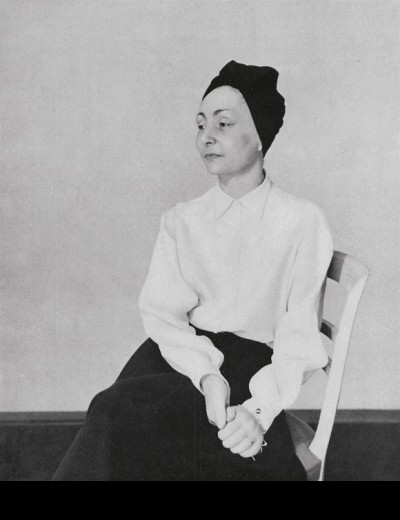
Germaine Emilie Krebs
About
Madame Gres was haute couture's sphinx, an austere and dignified person who dedicated her whole life to perfecting the art of draping and pleating vast amounts of cloth into a single gown. She defied the vulgarity of fashion and hated the glare of publicity. She was a genius who was admired by everyone in the fashion industry but died in obscurity and poverty.
Germaine Emilie Krebs was born in 1903 in Paris, France. Frustrated in her ambition to become a sculptor, she began her career by making Toiles for major Paris fashion houses. She worked for a time for the house of Premet.
In 1934, she opened her own house under the name of Alix Barton, and her gowns started to appear in fashion magazines under the name ALIX. She started experimenting with simple clothing, particularly jersey day dresses. Initially she was in partnership, and she decided to leave Alix, as the name belonged to someone else.
The Look
Grés' draped and pleated silk jerseys flattered the body with the minimalist and rationalist radicalism of 1930s design, but provided a classical serenity as well. The real achievement of the draped dresses was not their idyllic evocation, but their integrity. They were a unified construction, composed of joined fabric panels continuously top to bottom, fullest in the swirling flutes of the skirt, tucked at the waist, elegantly pinched through the bodice, and surmounted at the neckline— often one-shouldered—with the same materials resolved into three-dimensional twists. Grés was creating no mere lookalike to classical statuary, but a characteristically modern enterprise to impart the body within clothing. By the 1960s and 1970s, Grés was translating the planarity of regional costume into a simplified origami of flat planes, ingeniously manipulated on the body to achieve a minimalism akin to sportswear. Ironically, she who exemplified the persistence of couture treated the great dress with the modernist lightness of sportswear, and she who held out so long against ready-to-wear turned with a convert's passion to its possibilities in the 1980s, when she was in her late 80s. The personalizing finesse of a plait or wrap to close or shape a garment was as characteristic of Grés as of Halston or McCardell; her ergodynamics brought fullness to the chest simply by canting sleeves backward so the wearer inevitably created a swelling fullness in the front as arms forced the sleeves forward, creating a pouch of air at the chest. For evening, Grés practiced a continuous antithesis of body disclosure and hiding the body within cloth. Even the Grecian "slave" dress, as some of the clients called it, seemed to be as bare as possible with alarming apertures to flesh. But the Grés draped dress, despite its fluid exterior, was securely corseted and structured within, allowing for apertures of skins to seem revealing while at the same time giving the wearer the assurance that the dress would not shift on the body. Conversely, more or less unstructured caftans, clinging geometries of cloth, could cover the wearer so completely as to resemble dress of the Islamic world, but in these instances the softness of structure complemented the apparent suppleness. Never was a Grés garment, whether revealing or concealing, less than enchanting. The slight asymmetry of a wrap determined by one dart, the fall of a suit button to a seaming line, or the wrap of a draped dress to a torque of shaping through the torso, was an invention and an enchantment in Grés' inventive sculptural vocabulary. History, most notably through photographers such as Hoyningen-Heuné and Willy Maywald, recorded the sensuous skills of Madame Grés chiefly in memorable black-and-white images, but the truth of her achievement came in garden and painterly colors of aubergine, magenta, cerise, and royal blue, along with a spectrum of fertile browns. Her draped Grecian slaves and goddesses were often in a white of neoclassicism, but an optical white that tended, with exposure to light, to yellow over time. Grés' streamlined architecture of clothing was the pure white of dreaming, of languorous physical beauty, and apparel perfect in comfort and image.
Who Wears It
She did not design for the glitterati, but for rich women who conducted truly private lives. Among them were Gersende de Sabran-Ponteves, Duchess d'Orleans, Princess Ghislaine de Polignac, the Begum Aga Khan, Princess Grace of Monaco, Marella Agnelli and Marie-Helene de Rothschild.